Turkey is a country that is rich in history – from its long-standing Ottoman and Roman routes to the unsettling Byzantine era. As such, you can surely find some incredible historic landmarks in Turkey to explore.
Not only that, but Turkey has a landscape that is as diverse as it is wide. With breathtaking coastlines, over 45 national parks, cool deserts, and rugged mountains, there are many natural landmarks in Turkey for nature lovers to enjoy.
Whether you’re looking for archeological or architectural landmarks, Turkey is full of them.
From the iconic Hagia Sophia, Blue Mosque, Grand Bazaar, and Topkapi Palace, to the hidden gems of Mount Nemrut, Mount Tahtali, and Cappadocia, these are the top Turkey landmarks that you simply must visit.
Famous Landmarks in Turkey
Let’s begin with the most iconic and famous landmarks in Turkey. These postcard monuments are not postcard monuments for no reason! From the architecturally striking to the rich history, these are the most famous Turkey landmarks that are worth a visit.
1. Hagia Sophia, Istanbul
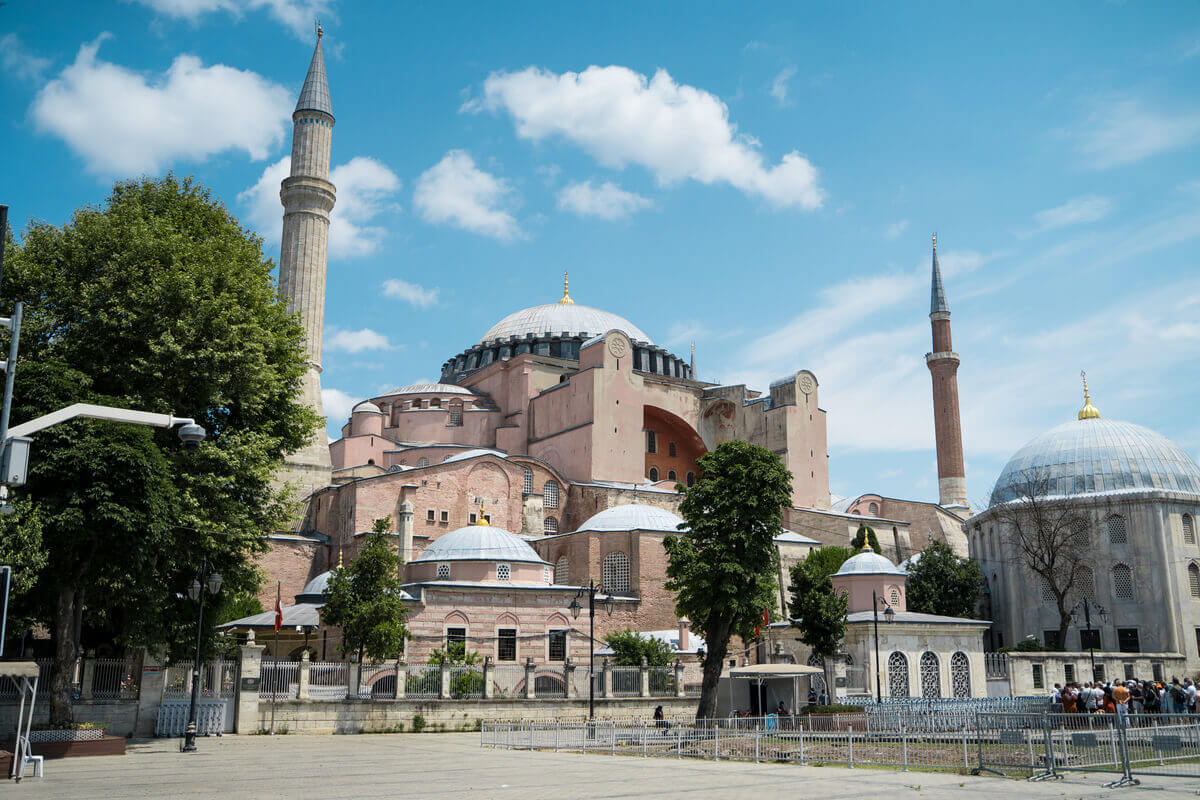
The Hagia Sophia is one of the world’s most stunning and important mosques. It was built during the Roman period in 537 by Emperor Justinian. It was built to serve as the cathedral of Constantinople. When it was first built, it was the largest Christian church in the Eastern Roman Empire and remained one of the largest for over 1000 years.
After Constantinople was captured by the Ottoman Empire, the Hagia Sophia was converted into a mosque. Today, you can still see where the faces of Jesus Christ have been covered over as faces are not allowed to be displayed in mosques.
The Hagia Sophia was converted into a museum in 1935 by the Republic of Turkey but was transformed back into a mosque in the year 2000 and it remains one of the most historic landmarks in Istanbul.
Inside, you can still see examples of architecture from the Byzantine era, showcasing intricately decorated mosaics, marble pillars, and artistic coverings.
2. Blue Mosque (The Sultan Ahmed Mosque)
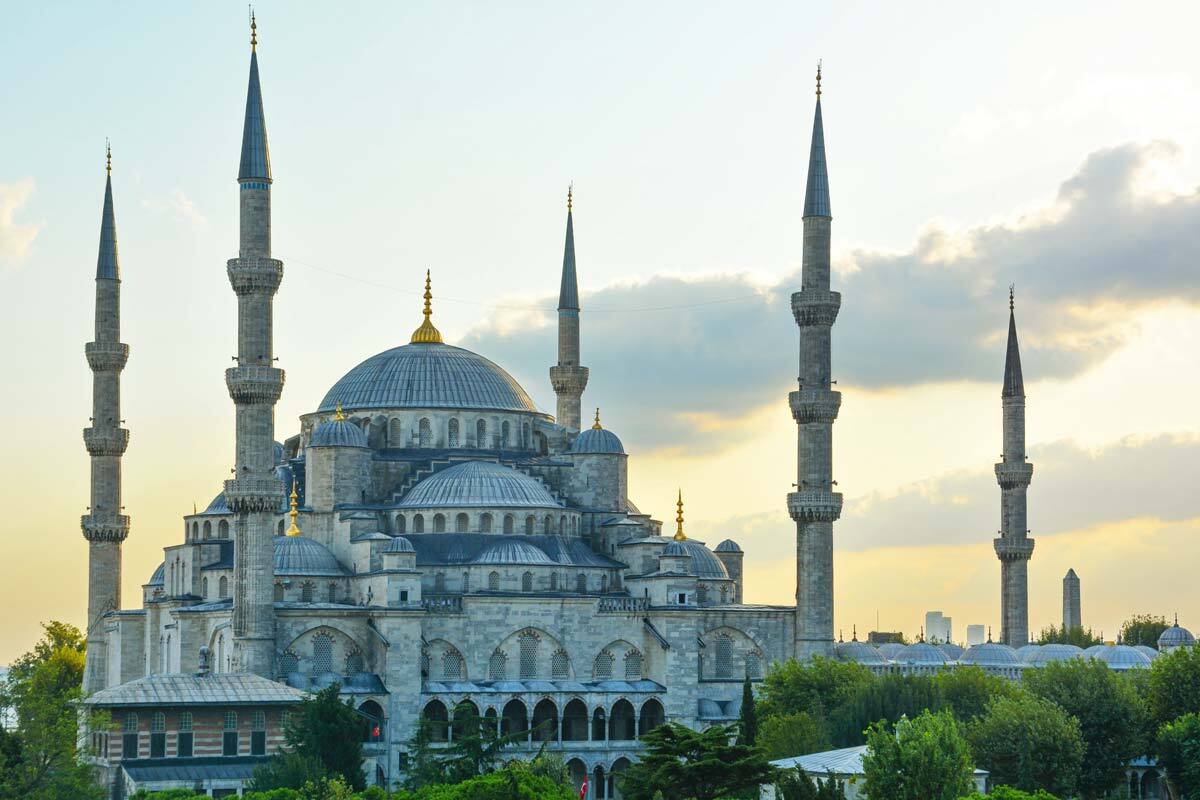
The Blue Mosque, also known as the Sultan Ahmed Mosque, is the most beautiful and striking piece of architecture in Istanbul. It was built between 1609 and 1616 under the rule of Sultan Ahmed I. It is famous for its hand-painted blue tiles that line the walls of its interior.
There are also more than 200 stained glass windows inside the Blue Mosque, as well as a stunning and beautifully carved marble mihrab which are worth a visit. It is also the resting place of Sultan Ahmed I and where you will find his tomb.
Although many people believe The Blue Mosque was named because of the blue tiles, it’s named after the color of the building which is bathed in blue light at night. Since it lies across from the iconic Hagia Sophia, this is a landmark in Turkey not to be missed.
The Blue Mosque has been a UNESCO World Heritage Site since 1985 and is one of Turkey’s most famous sites. The mosque is currently under renovation.
3. The Grand Bazaar, Istanbul
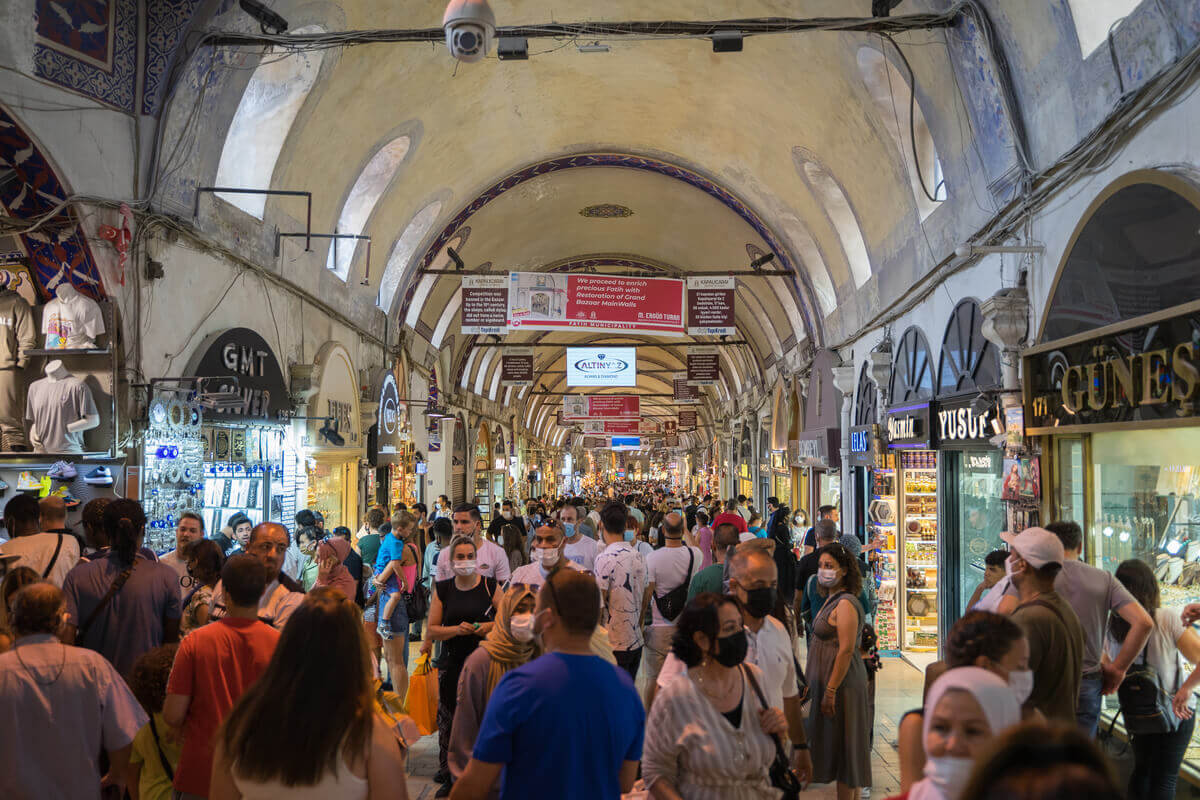
As one of the largest and oldest markets in the world, with 61 covered streets and over 4,000 shops, the Grand Bazaar is one of the oldest shopping malls in the world. It was even considered one of Istanbul’s most visited tourist attractions in 2014, and it’s easy to see why.
The vibrant shopping streets in the Grand Bazaar are a bustling maze of souk markets and stalls, where you can buy anything from Turkish delights, Turkish lamps, rugs and mats, towels, clothes, and other souvenirs to take home after your trip. It began operating in 1455, shortly after the Ottomans seized Constantinople.
Around the corner from Grand Bazaar, you will also find the Spice Market in Istanbul, which is a great place to stock up on various teas and spices that are designed to cure certain medical conditions – from mood-enhancing teas to diabetes control, and even sexual-performance enhancers!
4. Sumela Monastery
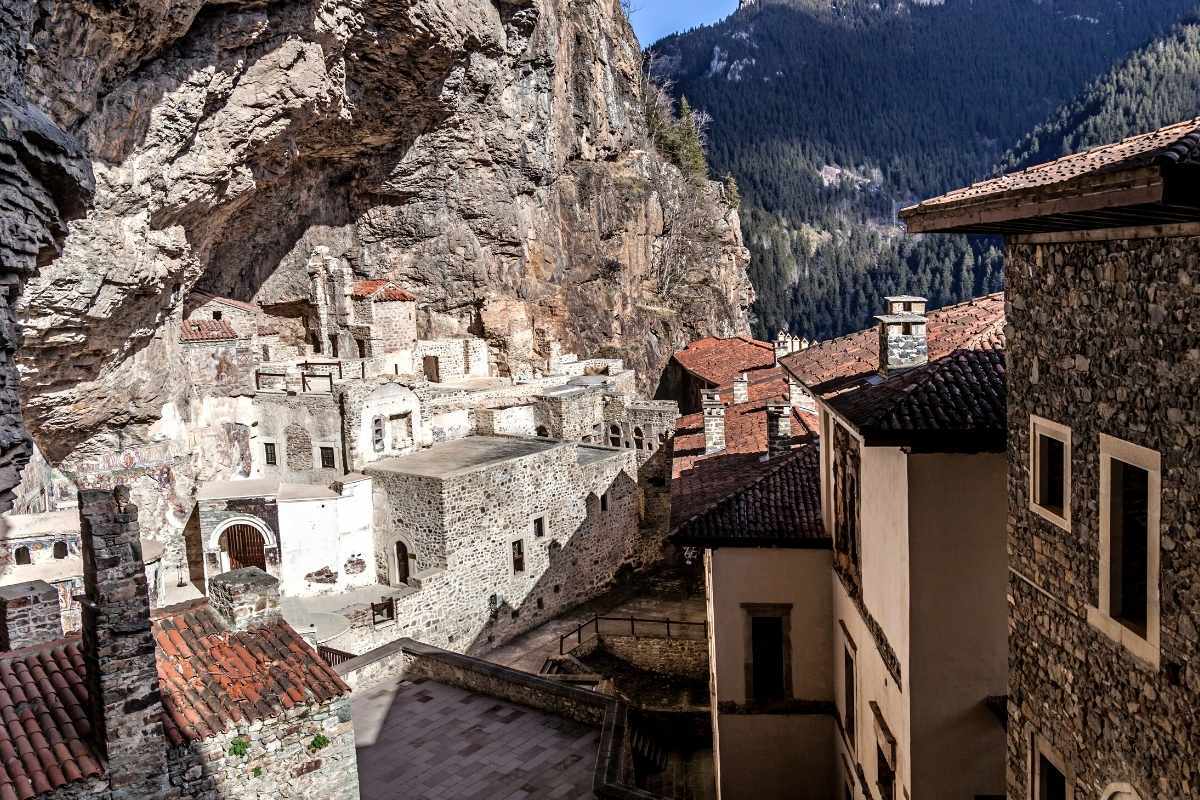
The Sumela Monastery is a Greek Orthodox monastery located in Karadağ in the Pontic Mountains. The church is dedicated to the Virgin Mary and dates back to 386 AD during the reign of Emperor Theodosius I.
It is said there is a painting inside the monastery of the Virgin Mary that was painted by the Apostle Luke.
What makes the Sumela Monastery so special and unique, is its location. Nestled on the mountainside at an altitude of about 1,200 meters (3,900 ft) above sea level, it’s one of the most striking pieces of Architecture in Turkey.
The monastery faces the Altındere valley, a significant site in the Altındere National Park, known as being the center of Christianity many years ago.
Its location, however, has subjected it to several states of damage over the years due to falling rocks and weathering. The monastery has undergone several stages of reconstruction and renovation over the years, and the last batch of renovations was completed in 2017.
The monastery is still frequently visited by monks, Christians, and Muslims on pilgrimages.
5. Ephesus
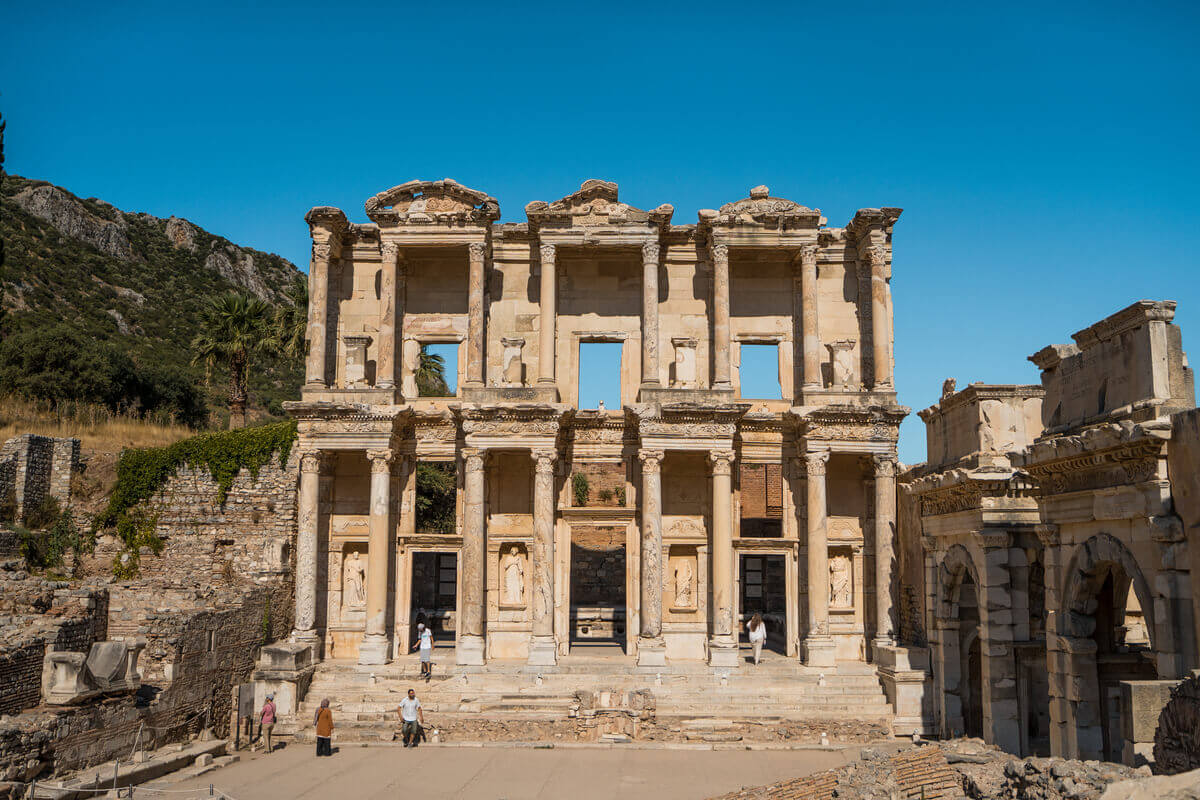
No trip to Turkey would be complete without stopping by one of the most famous landmarks in Turkey and the UNESCO World Heritage Site of Ephesus.
The ancient ruins date back to the 10th century BC by the Ancient Greeks. The city lies on the coast of Ionia and covers an area of 6.6 square kilometers.
Today, the Greek city lies in ruins but is still frequently visited for its well-preserved Greco-Roman architecture. The most notable site at this historic landmark is the Temple of Artemis, which has been dubbed one of the seven wonders of the Ancient World.
It’s also famous for its Library of Celsus, Temple of Hadrian, and of course, the Roman Amphitheater which is large enough for 24,000 spectators.
It’s also a religiously significant landmark in Turkey, as it’s said the Gospel of John may have been written there.
6. Galata Tower
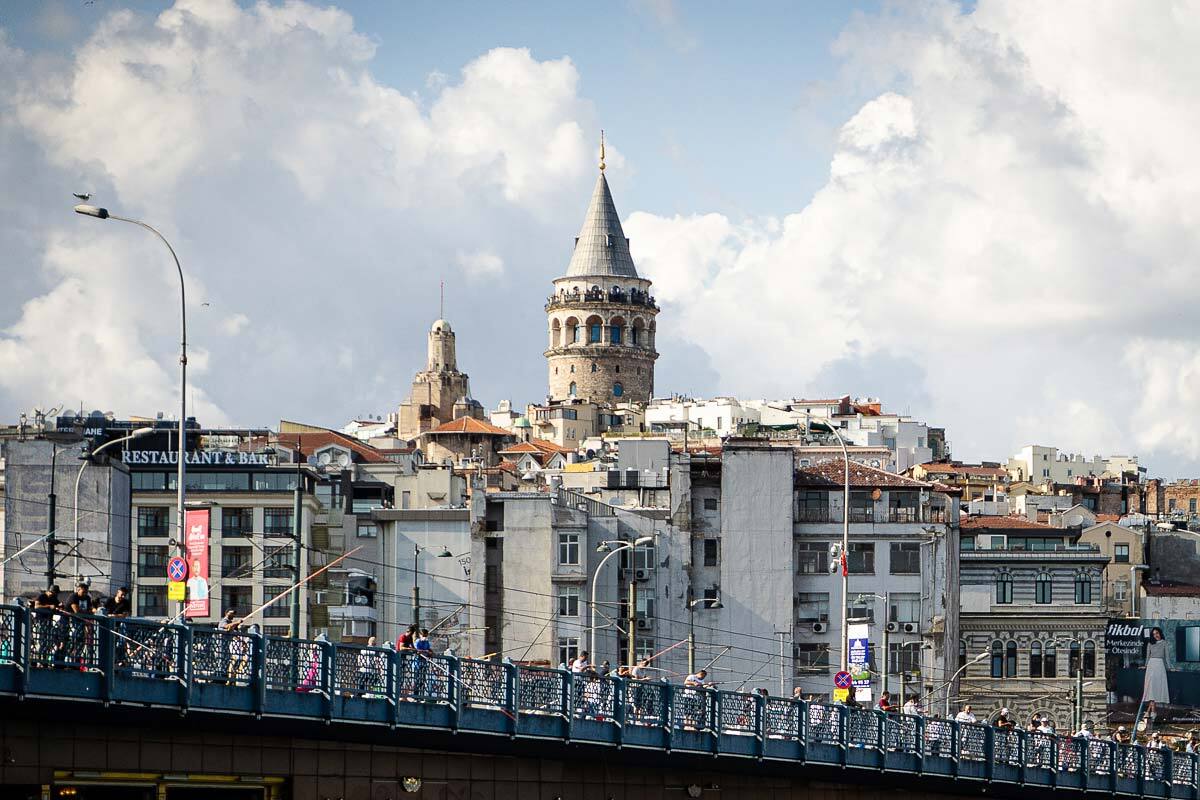
The Galata Tower is one of the most famous landmarks in Istanbul, given that it can be seen from most areas in the city. The watchtower was built as a part of the Walls of Galata in 1348 under the reign of the Roman Empire.
The upper section of the tower was modified after Constantinople was taken over by the Ottoman Empire, but most of the tower is true to its original form and architecture. That is all except the roof.
During the Ottoman era, the tower was used to spot fires in the city, but in 1794, the tower caught fire, and the roof that was originally made of lead and wood, was largely destroyed.
In 1831, it caught fire again, leading to more restoration work. In 1875, the roof was destroyed during a storm and was once again rebuilt.
In the 1960s, the roof was renovated using concrete instead of wood and was also commercialized so tourists could climb to the top to see panoramic views of Istanbul.
In 2013, the tower was made a UNESCO World Heritage Site in Istanbul. The tower is now a museum and exhibition hall and is regarded as one of the most famous sites in Istanbul Turkey.
Natural Landmarks in Turkey
Turkey has some of the richest biodiversity on the planet, and as such, there are tons of places to visit for nature lovers. From its sprawling Mediterranean coastline to its vast deserts, these are the best natural landmarks in Turkey.
7. The Fairy Chimneys of Cappadocia
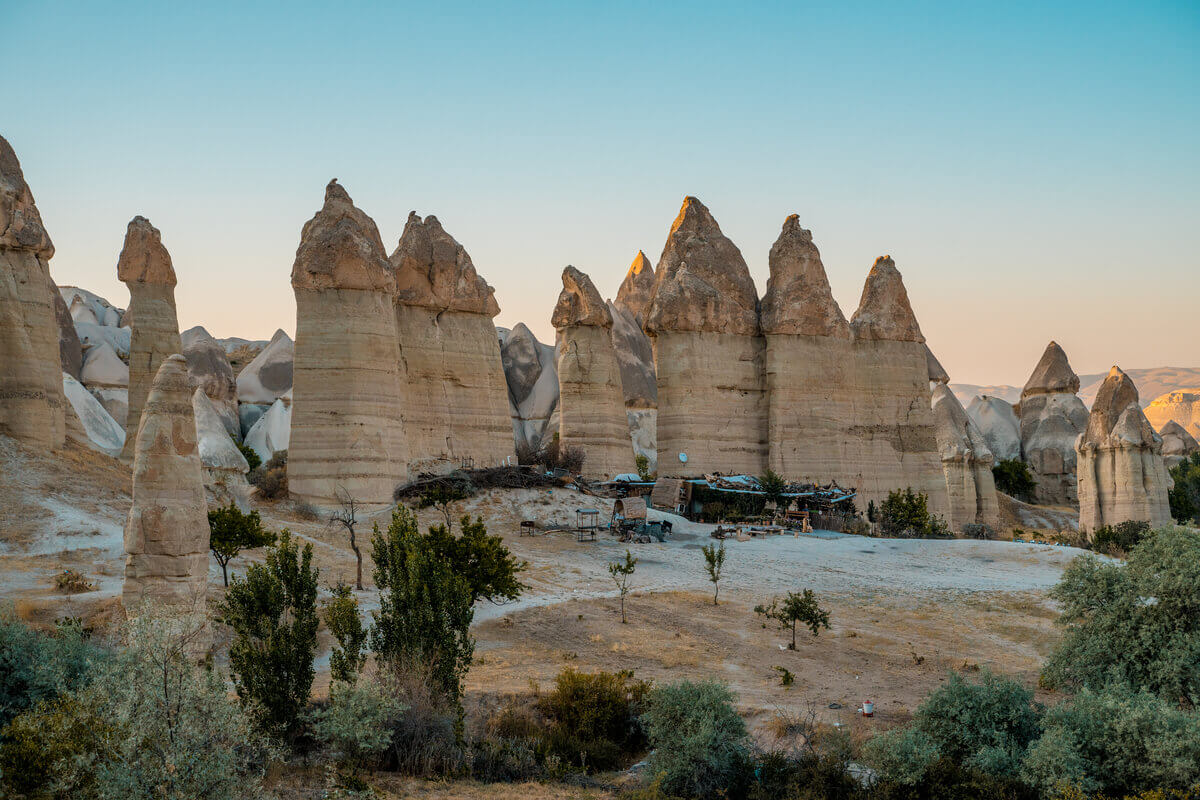
The fairy chimneys are rock formations that are most commonly seen in the Central Anatolia region of Cappadocia and are said to date back to the Bronze Age.
Legend has it, that persecuted Christians some 1500 years ago fled the capital of Constantinople to the Cappadocia region, where they learned the soft volcanic rock of the fairy chimneys was porous and easy to shape. They turned the fairy chimneys into houses. They also formed many cave dwellings, churches, monasteries, and other settlements around this area.
But the fairy chimneys were not created by the Christians of the Roman Empire. They were formed by hardened ash from volcanic eruptions, which was covered by a layer of basalt.
Over the millennia, the chimneys eroded and formed these pillars that stand 310 feet high. As the hard basalt erodes at a slower pace, a mushroom-shaped cap forms at the top, giving them their distinct, and slightly phallic, shape. Visitors can easily see this phenomenon in the Love Valley of Cappadocia.
8. Travertine Terraces of Pamukkale
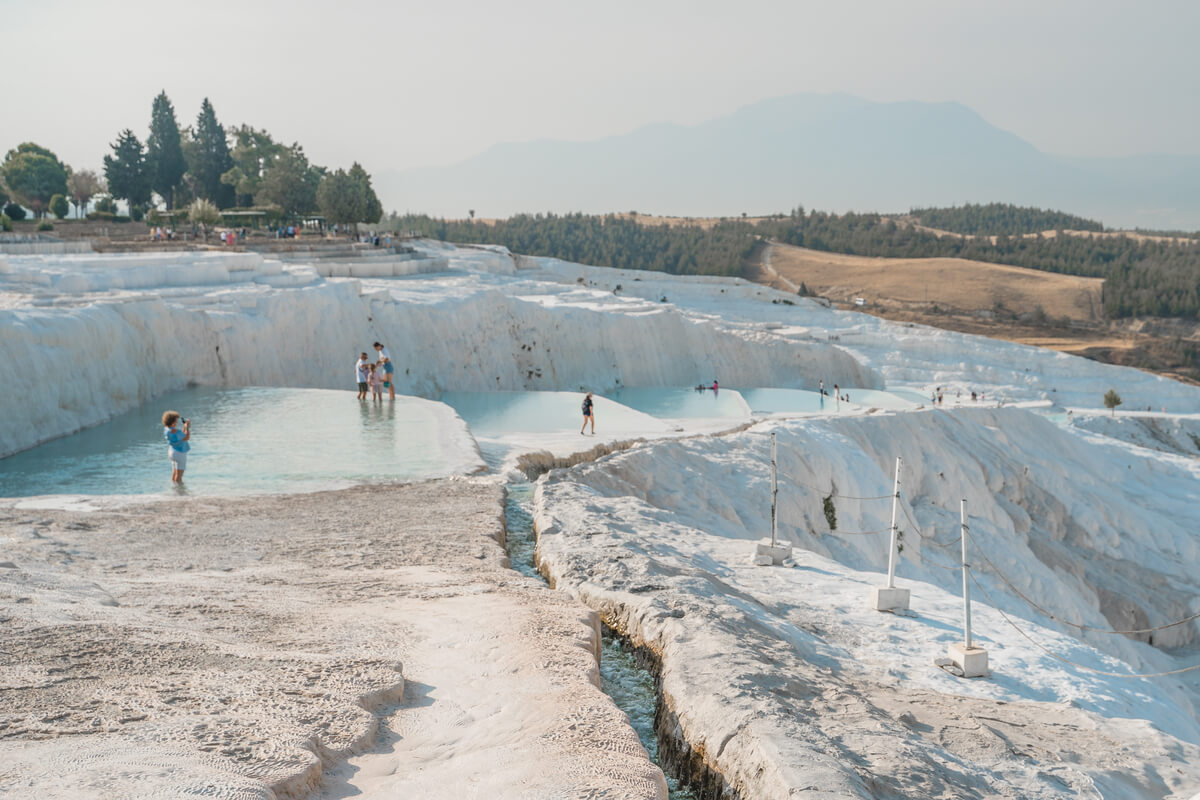
The travertines in Pamukkale are Turkey’s most famous natural wonder. Pamukkale, which means cotton castle in Turkish, refers to the shimmering, snow-white limestone pools that have been shaped by calcite-rich mineral waters that drip over the mountainside for centuries.
It is said that the terraces, or travertines, contain solidified cotton, which is the area’s principal crop.
These natural hot spring pools are what bring many tourists to the area, as they are perfect for swimming in as the weather is temperate all year round.
There is also a thermal Roman bath in the Medieval Hierapolis, which was built during the early 7th century. This bath is still frequently visited by tourists each day.
At the top of the mountain, you will find the ancient ruins of the ancient Greek city of Hierapolis, which has been a UNESCO World Heritage Site since 1988.
The ruins cover a space of about 2,700 meters and the most iconic remains are the amphitheater, the Hadrians Gate, Tomb of Philip the Apostle, and the Temple of Apollo.
9. Kaputas Beach
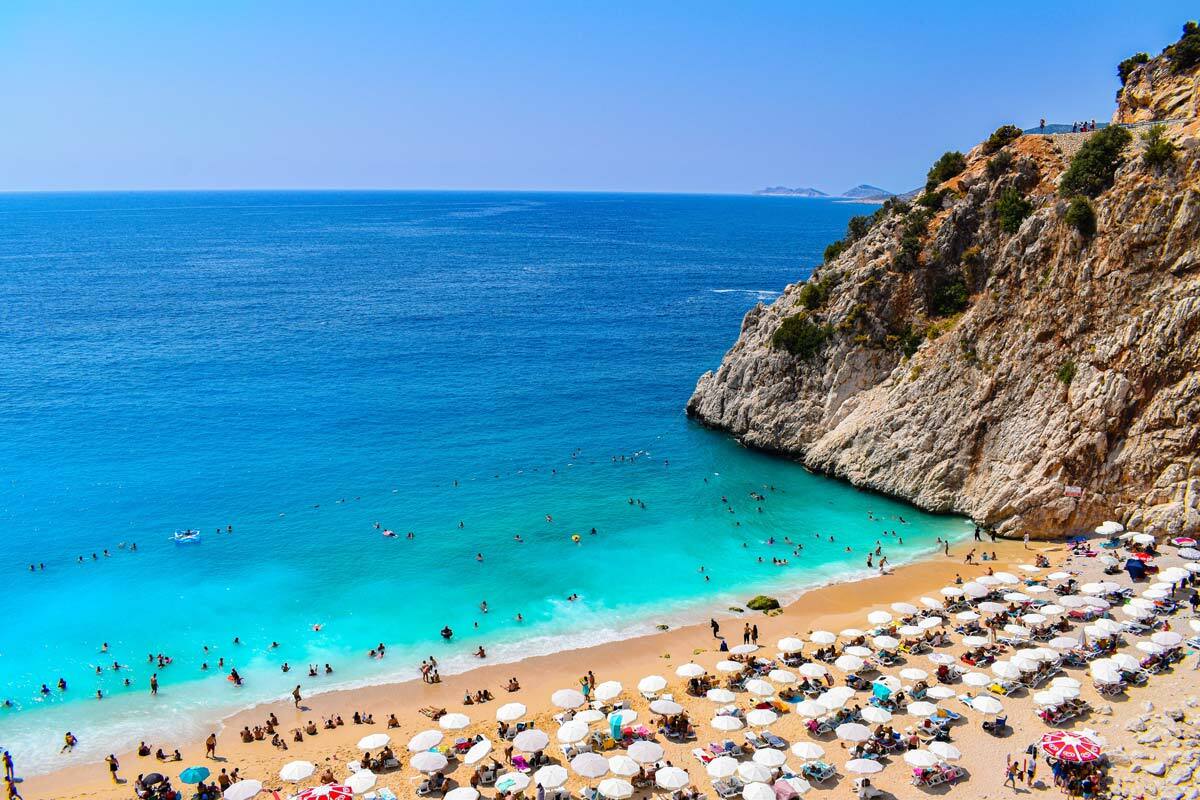
Turkey is not short of amazing beaches to visit. One of the most popular and famous beaches is in the Antalya region known as Kaputas Beach.
The beach is known for its turquoise blue waters, soft sandy beach, and surrounding rocky cliffs, creating a sheltered bay that protects the beach.
Located on the Lycian Coast, Kaputas Beach is a popular spot for cliff jumping and swimming. Visitors can rent a sunbed, or enjoy refreshments from the nearby beach bars. Because of its unique landscape, it is often regarded as the most beautiful beach in Turkey.
10. Mount Nemrut
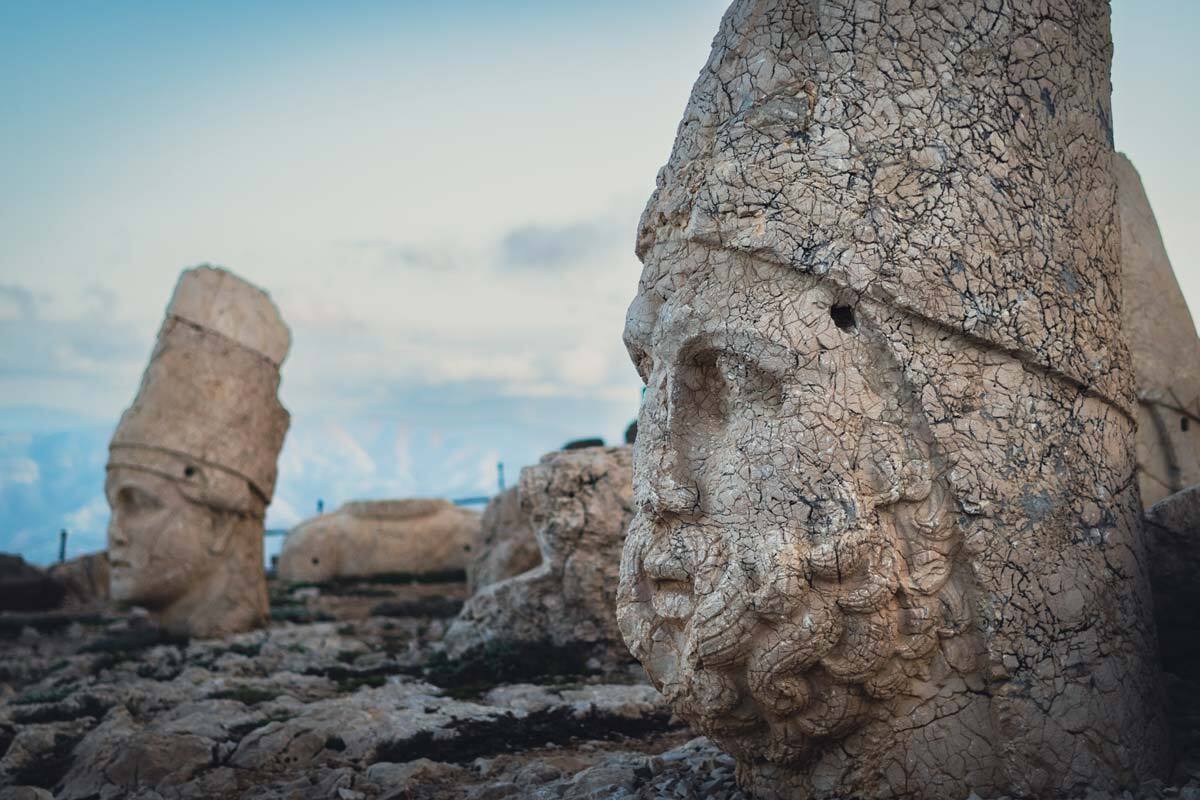
Mount Nemrut, or Mount Nemrud, is a mountain in South Eastern Turkey and belongs to the Taurus Mountain Range. It is the largest peak in the region.
Mount Nemrut is one of the most unusual Turkey landmarks and is best known for its collection of large statues that scale the perimeter of its 2134-meter-high summit.
It is said that in 62 BC, the site was built by King Antiochus I Theos of Commagene as a tomb and sanctuary. He built several of these large statues, some as tall as 8-9 meters high. The statues are of himself, two lions, two eagles, and various Ancient Greek and Iranian gods.
The statues were once seated and inscribed with the names of the gods they resembled. It is not known when, but at some point in time, the heads were removed from their bodies and scattered across the site.
Despite several excavations over the years, no tomb has ever been found, though Archeologists believe Antiochus I is buried there. The statues have never been touched nor restored, and as such, the site was made a UNESCO World Heritage site in 1987.
Nowadays, it has become one of the most popular hikes in Turkey as it offers travelers both stunning views and a little bit of history.
11. Carian Rock Tombs of The Dalyan Delta
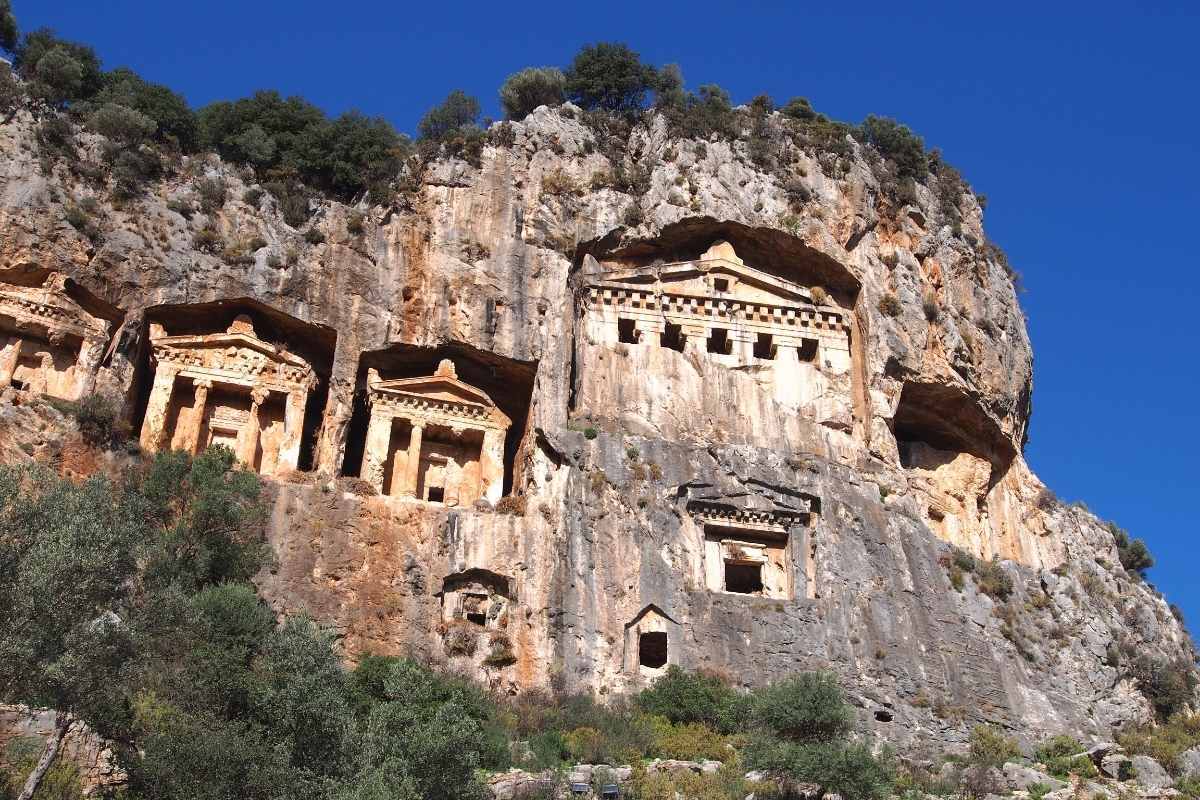
The Dalyan Delta is an area of outstanding natural beauty and a nesting site for the endangered loggerhead turtles. Because of this, environmentalists have successfully campaigned against the redevelopment of the area and many large-scale hotels have been refused permission to build here.
For that reason, it is one of the most unspoiled natural landmarks in Turkey.
What brings tourists to this stunning location is not just nature, but the Ancient City of Kaunos, where visitors can see the well-preserved port city that is said to date back to the 9th century, possibly even earlier.
The main attraction of the city and its surrounding areas are the Carian rock tombs, which have ornately decorated façades that resemble the front of Hellenistic temples.
There are approximately 167 tombs in the area, and their style is very individual and unique to this region, which is why they are regarded as a special landmark in Turkey. In 2014, the ancient city was named a UNESCO World Heritage Site.
12. Mount Tahtali
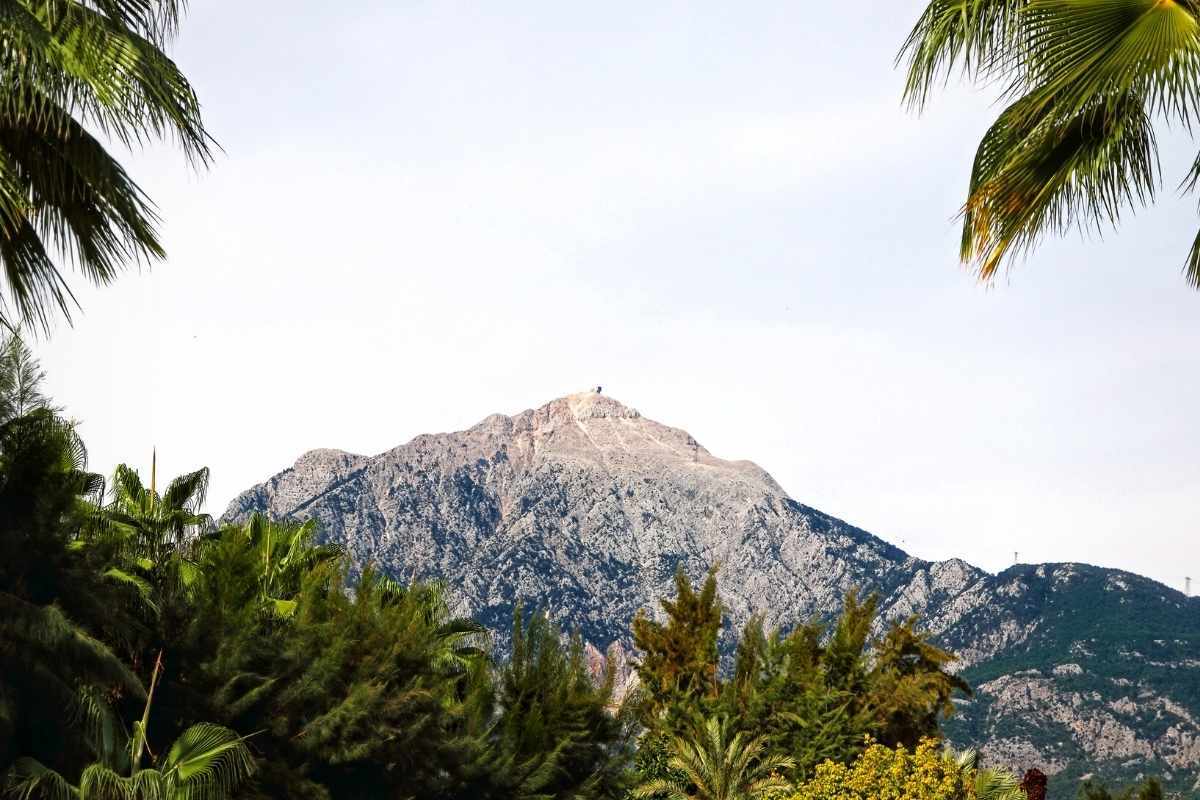
Mount Tahtali has many names. Tahtalı Dağı, Lycian Olympus or Mount Olympus, is a mountain in the Beydağları Coastal National Park, a quick day trip from Antalya, and near Kemer.
In ancient times, the mountain was called Mount Olympus, the famous home of the Greek gods. At the top of Mount Olympus was a temple of Hephaestus, and at the base of the mountain, lie the ruins of the ancient city of Phaselis.
Today it is referred to by its Turkish name, Tahtali. The word taht means “throne” in Turkish, which refers to the fact that Mount Olympus was the throne of the Gods.
In 2007, a funicular cable car was built to take visitors up the mountain. It is also a popular hiking spot, as the Lycian Way long-distance trail winds up the mountain. In the winter months, it is possible to see snow at the peak of the mountain.
13. Manavgat Waterfalls
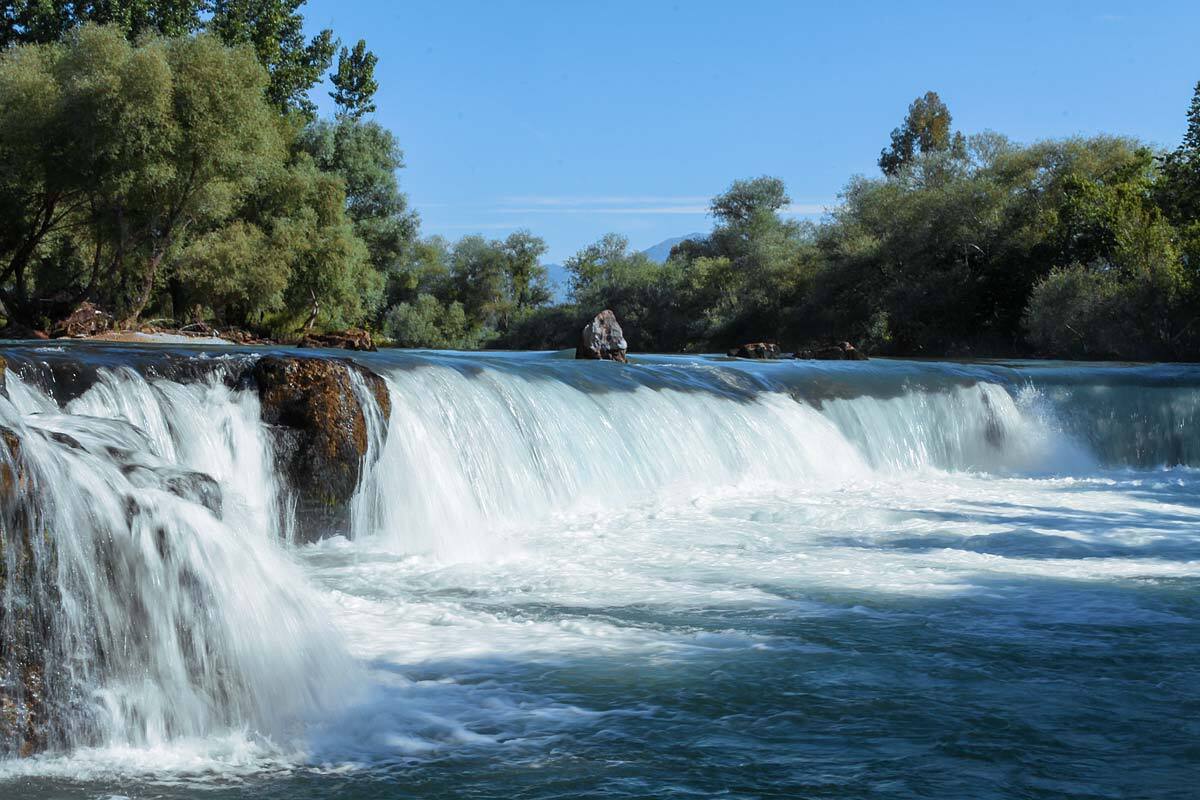
One of the most underrated and least talked about natural wonders in Turkey is the Manavgat Waterfalls.
Located on the Manavgat River, near the stunning Turkish cities of Side and Manavgat, this high-flow waterfall cascades over shallow rocks. Since the river here is wide, and the waterfall isn’t too steep, it created a white, foamy water flow that is best seen from above.
Next to the waterfall is a tea garden, which provides the perfect place to sit and admire this beautiful natural Turkish landmark in all its glory. It was also depicted on the back of the 5 lira banknote between 1968-1983.
14. Blue Lagoon, Ölüdeniz
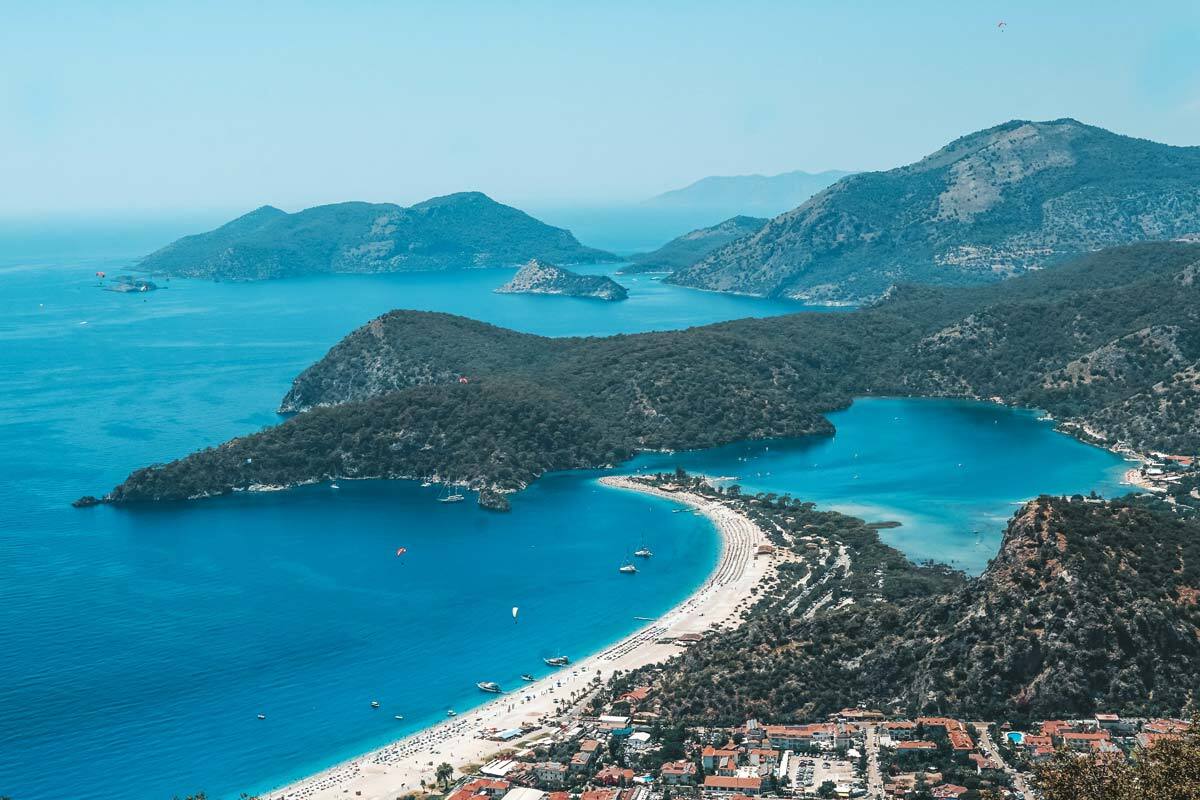
Another natural landmark in Turkey not to be missed is the jaw-dropping Ölüdeniz Blue Lagoon. The lagoon is located outside the town of Fethiye in the Ölüdeniz National Park.
The lagoon is separated from the sea by a sandbar that separates the ocean from this azure turquoise water. There is a beach on either side of the sandbar, with soft sand and shallow waters for swimming in.
Since there are no boats allowed, there is nothing to disturb the peace and tranquility of this place. However, canoes and paddleboats can be hired from the inner shores of the lagoon. In this scenic area, it is possible to see turtles, mussels, and tons of tiny fish.
The Blue Lagoon is one of the most photographed and famous landmarks in Turkey and is often referred to as the most beautiful place in the country.
If you want to get a good bird’s eye view of the Blue Lagoon, then make sure you go paragliding. The paragliding in Oludeniz is considered one of the best places to do so in the world!
15. The Burning Flames of Chimaera
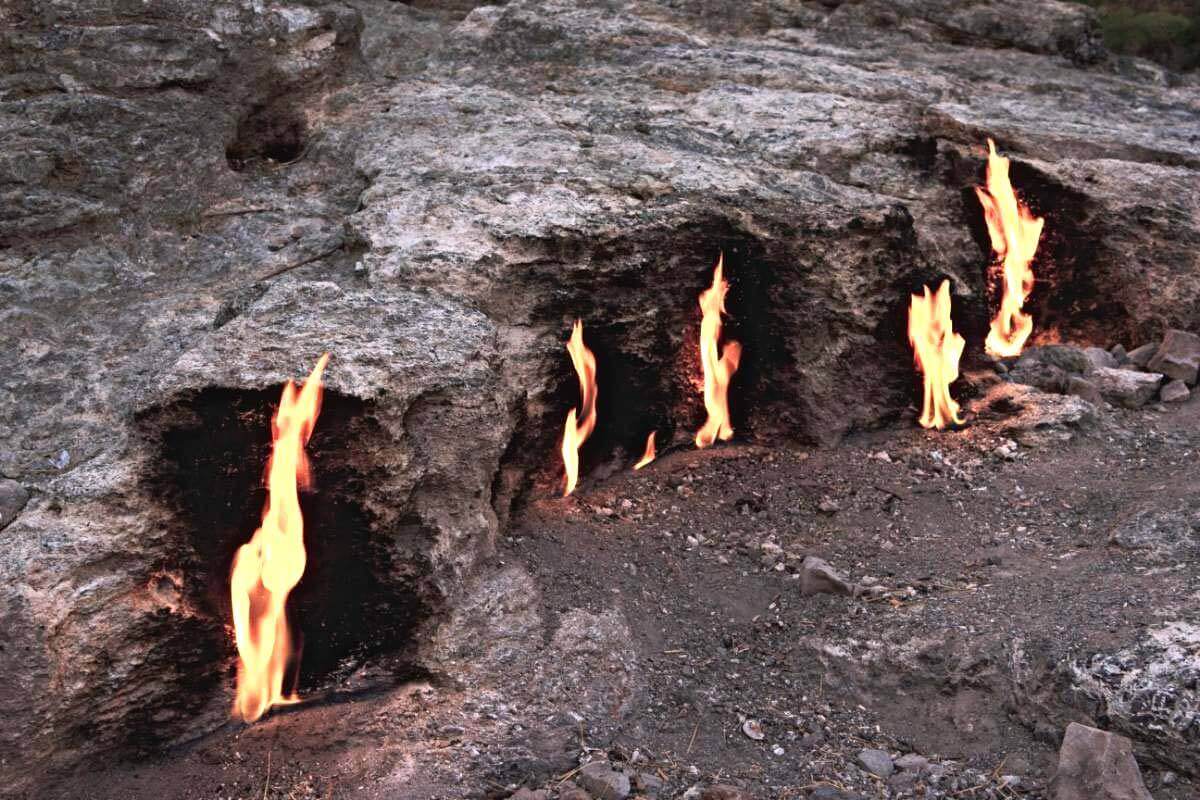
Another one of the must-visit Turkey landmarks is the Burning Flames of Chimaera, a natural burning gas that has been burning for almost a millennia.
According to local myths and legends, the fires belonged to the breath of a monster that was part goat, part snake, and part lion.
However, scientists discovered in 2014 that the source of the flame is gas escaping from deep within the Earth. The gas is formed by a chemical reaction inside the rocks, which is apparently not uncommon.
The Burning Flames are found in Turkey’s Olympos Beydağları National Park in Southwest Turkey. They are found on a mountain of the same name, Mount Chimaera.
Historic Landmarks in Turkey
With a history that dates back almost 4,000 years ago, there are many tourist attractions and famous landmarks in Turkey that offer insight into its fascinating and sometimes gruesome past.
If you’re a history lover and want to learn more about the Byzantine and Ottoman Empires, or even as far back as the monolithic age, then you’ll want to make a trip to these famous Turkish landmarks.
16. Derinkuyu Underground City
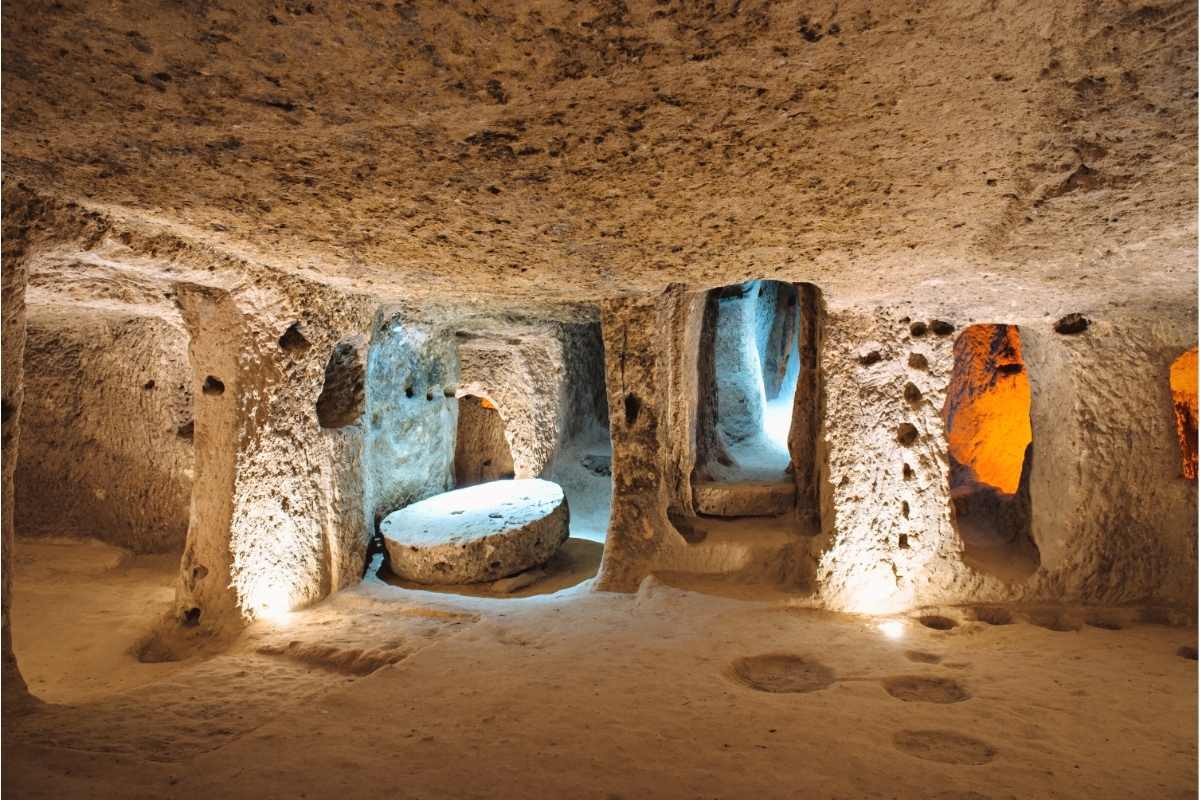
There are two main excavated underground cities in Cappadocia; the Derinkuyu Underground City and the Kaymakli Underground City. The largest and most famous underground city is the ancient Derinkuyu Underground City.
The multi-level underground city is located in the Nevşehir Province of Cappadocia, just 35km South of Goreme. It reaches a depth of approximately 85 meters (279 ft) and was capable of housing 20,000 people and their livestock and food stores in its time.
The city at Derinkuyu was formed in the Byzantine era and was used by Christians as protection from Muslim Arabs during the Byzantine Wars. The city is connected to other underground cities by a series of underground tunnels and caverns, but some tunnels are still yet to be excavated.
Artifacts discovered in the city are said to date back to the 7th and 8th centuries BC.
The ancient underground cities were used up to the 20th century by the Greeks living in Cappadocia who needed them to escape persecution.
17. Dolmabahce Palace
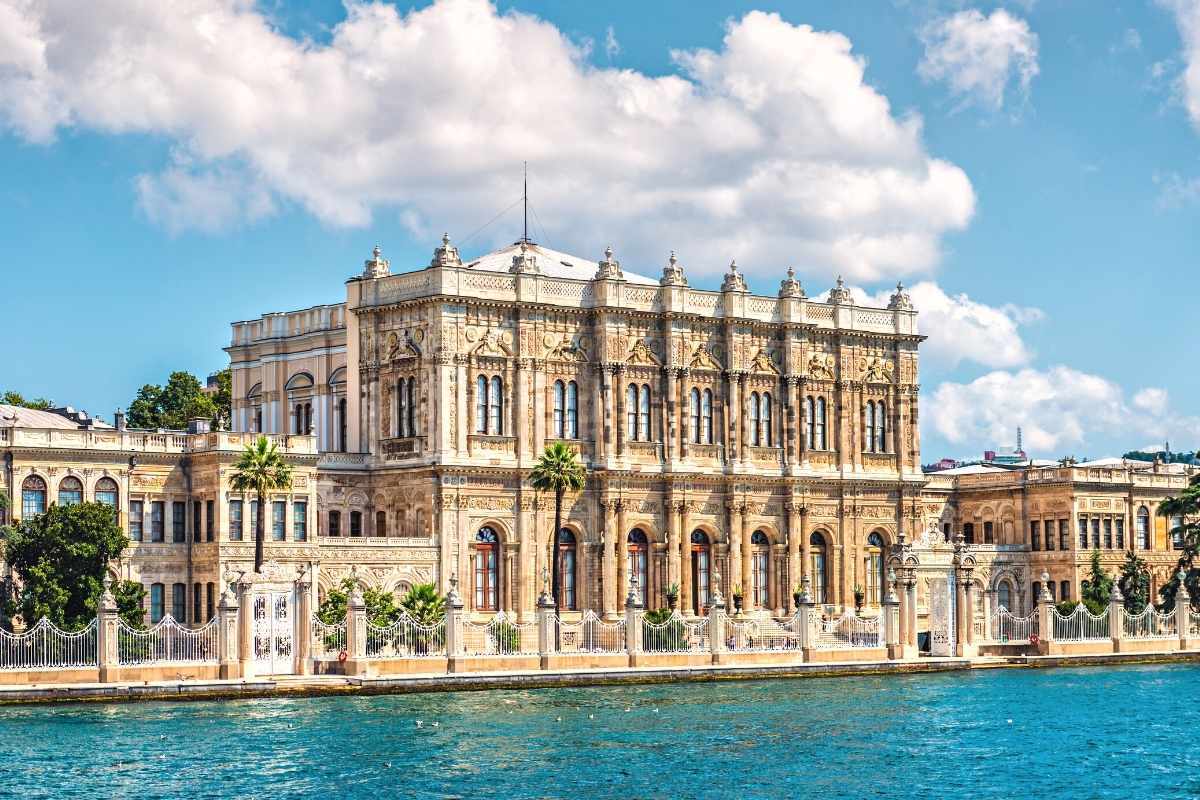
Another famous landmark in Istanbul is the Dolmabahce Palace, located on the European side of Istanbul in the Beşiktaş district. It is the largest palace in Turkey and is famous for being the main administrative center for the Ottoman Empire between 1856-1887 and 1909-1922.
It has 285 rooms and 46 halls, as well as 6 bathrooms and 68 toilets. It is said that one of the largest diamonds in the world is displayed in a special showcase in the hall. It features architecture from Baroque, Rococo, and Neoclassical styles, as well as traditional Ottoman styles.
This Turkish landmark was built by Abdülmecid I, the 31st Sultan of the Ottoman Empire. It was built between 1843 and 1856 and was built as his family home.
Since its inception, it was the family home of 6 sultans until the Empire was abolished in 1924. The last royal to live in the palace was Caliph Abdülmecid Efendi, and after the end of the Empire, ownership was given to the national heritage of the new Turkish Republic.
It was said to have cost five million Ottoman gold lira, which equates to around $1.9 billion in 2021 value. This cost a quarter of the yearly tax revenue and placed an enormous financial burden on the state.
18. Zelve Open Air Museum
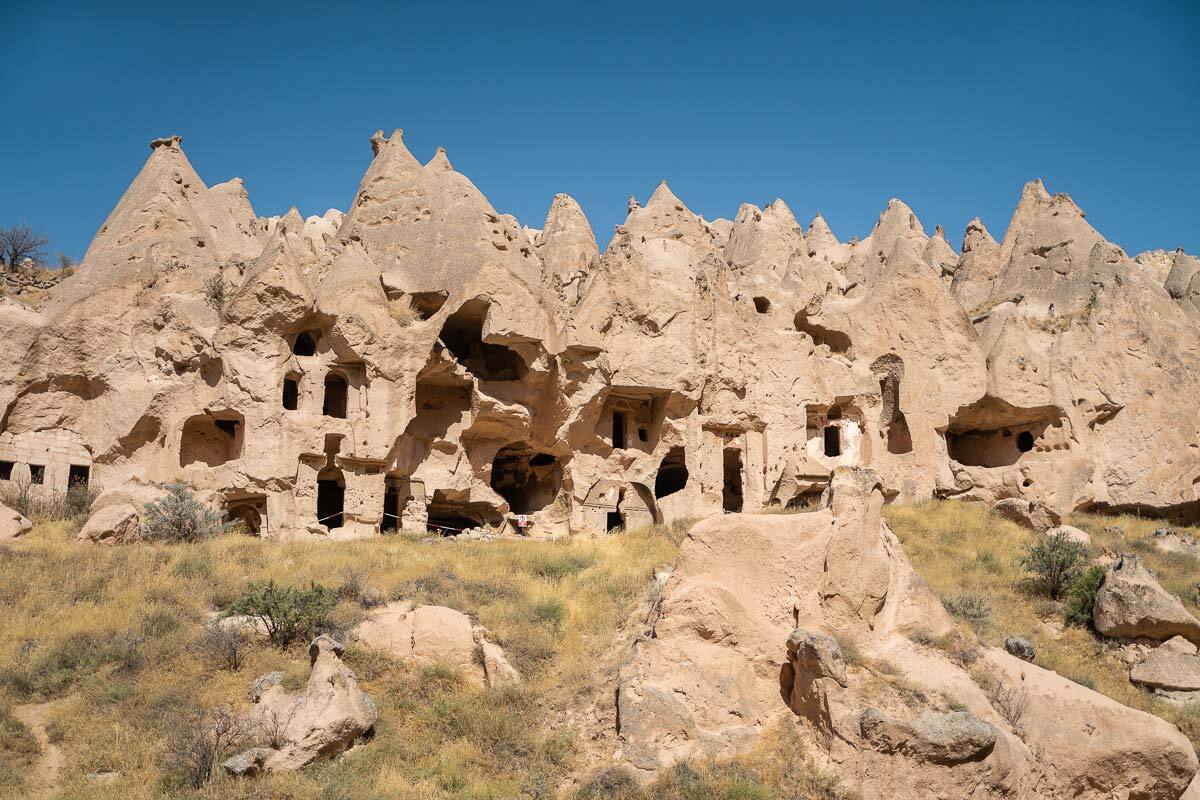
If you are traveling to Cappadocia and want to learn more about the ancient civilizations that lived here, then the Zelve Open Air Museum is one landmark in Turkey that should not be underestimated.
The museum showcases how ancient civilizations used the rock formations known as fairy chimneys as settlements. The three Zelve Valleys are a great short hike in Cappadocia, and hikers can see caves that were used as houses, churches, bakeries, stables, and more. The museum is located just 5 kilometers south of Avanos.
It is said they were built during the Byzantine era, and the oldest churches date back to the year 500. In Cappadocia, there are only a few sixth-century churches, and more than half of them are at Zelve.
Humans lived in Zelve right up to the 1950s, when the last family moved to nearby Aktepe because the falling rock and collapsing ceilings became too dangerous for them to live in.
Another must-visit attraction in Nevsehir is the Uchisar Castle. Similar to the Zelve Museum, it was constructed out of porous volcanic rock and was used as the main point of defense in the region.
19. Temple of Aphrodite
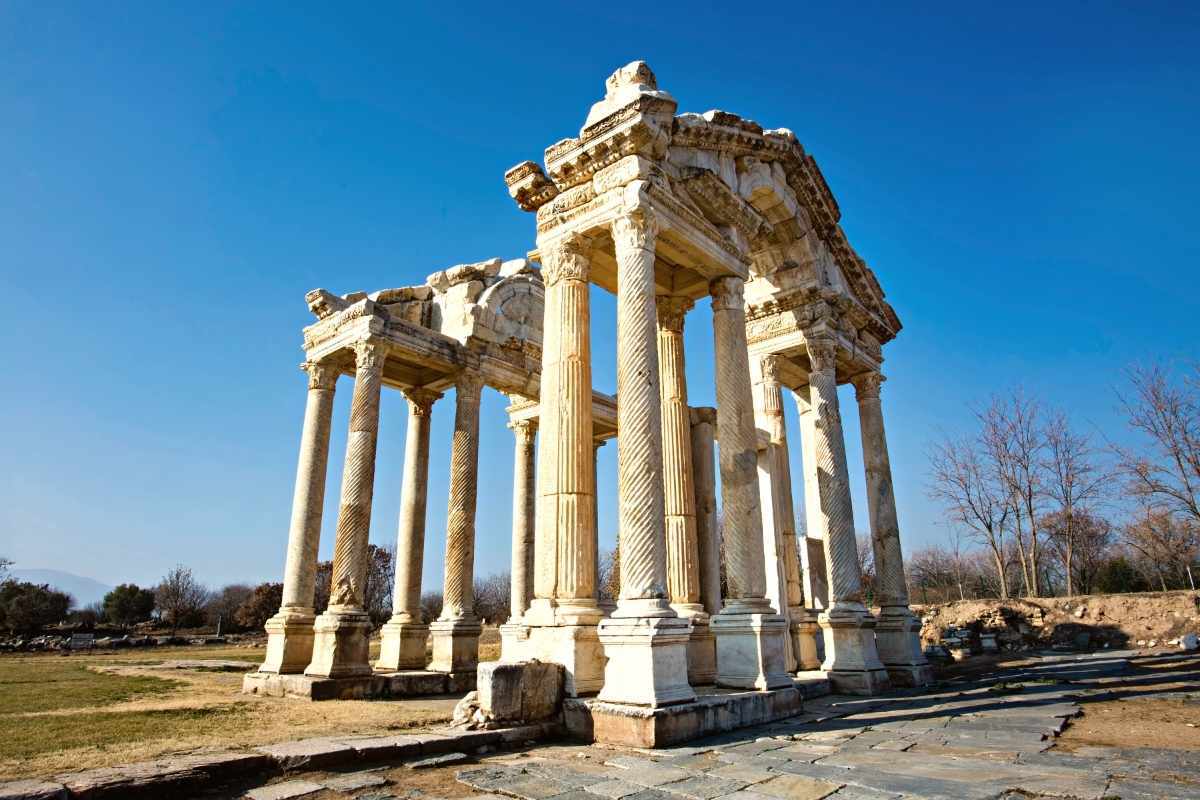
The Temple of Aphrodite is one of the most historical landmarks of Turkey to be discovered. Its ruins are found in southwestern Turkey, in the valley of the Morsynus River. It is said the temple dates back to the 3rd century BC and the city was built in the 4th century.
The nearby marble quarries provided a lot of wealth to Aphrodisias, who used the stone to create statues for its sculptors. The city’s streets were arranged around several of these large structures, including temples, a theatre, an agora, and two bathhouses.
The well-preserved ruins were added to the UNESCO World Heritage list in 2021 and are one of the newest landmarks of cultural and historical importance in Turkey.
20. Topkapi Palace, Istanbul
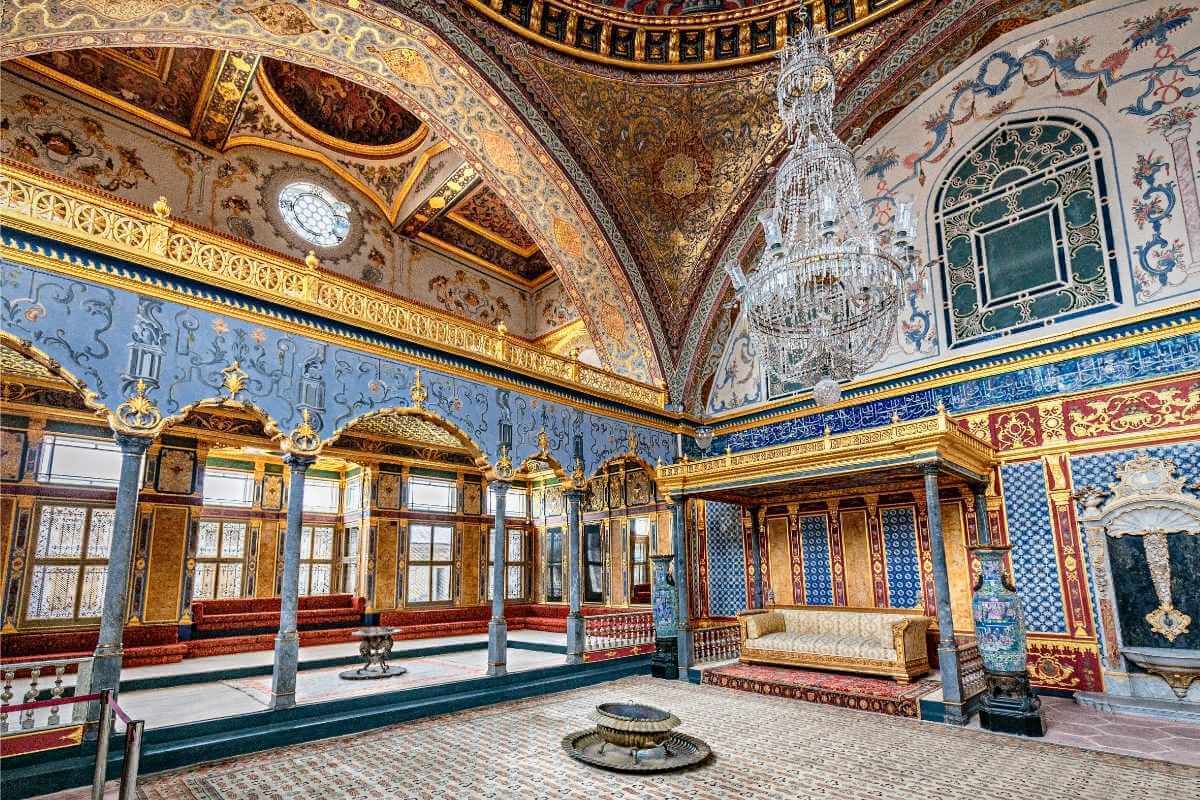
Another one of the most famous Turkish landmarks is the Topkapi Palace. This palace in Istanbul was once the home of the Ottoman sultans during the 15th and 16th centuries.
Today, it is a large museum, displaying collections of clothing, weapons, miniatures, religious artifacts, and manuscripts. Not all rooms are open to the public, only the most important ones, such as the Ottoman Imperial Harem and the treasury. The treasury is where the Spoonmaker’s Diamond and the Topkapi Dagger are kept.
The palace was built in 1459 by order of Sultan Mehmed the Conqueror, six years after he seized Constantinople. The palace has been expanded over the centuries, with major renovations carried out after an earthquake in 1509 and a fire in 1665.
The palace complex also has four main courtyards and many smaller buildings, where female members of the family live in the harem. There were also homes for state officials, including the Grand Vizier, and an Imperial Council building.
After the 17th century, the sultans preferred to stay in the larger and more expensive Dolmabahçe Palace, but Topkapı still remained the city’s treasury. In 1985, UNESCO recognized this landmark in Istanbul as one of great importance and is still one of the most popular tourist attractions in the city to visit.
21. Anıtkabir
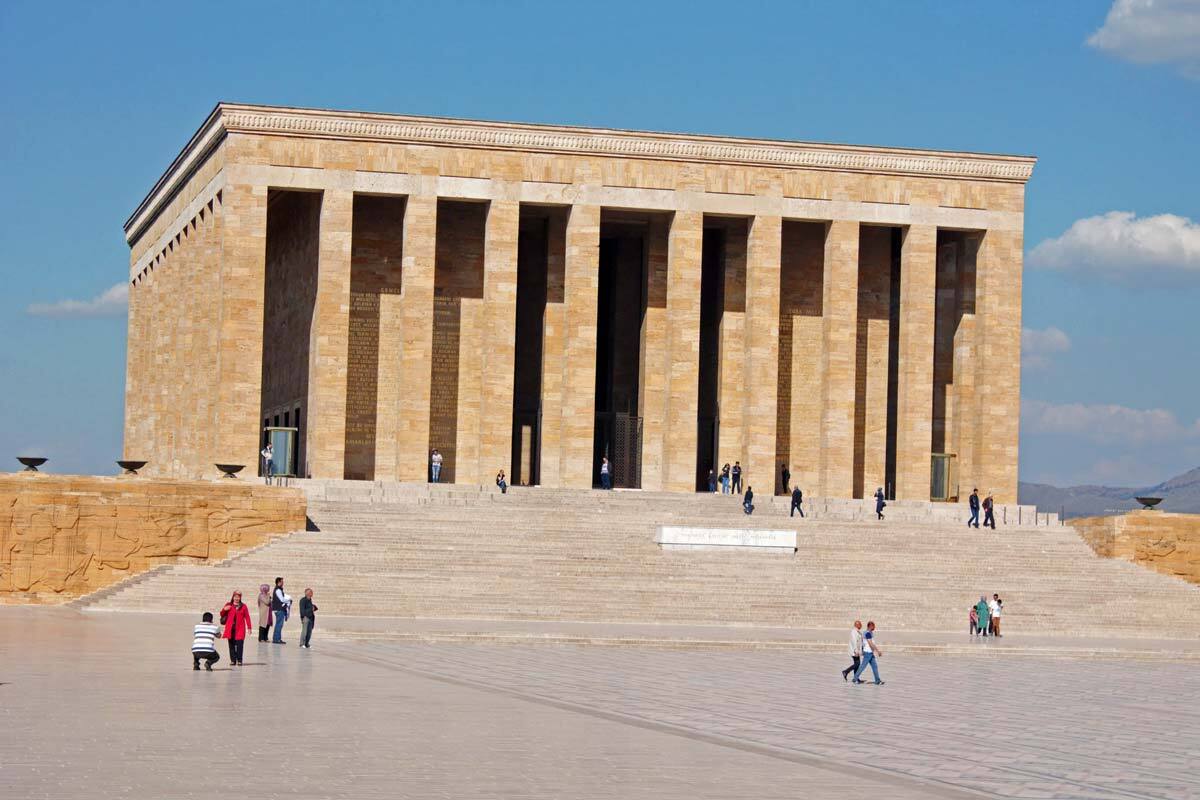
Anıtkabir is the mausoleum of the leader of the Turkish War of Independence and first President, Mustafa Kemal Atatürk. It is located in the city of Ankara and was designed by Professor Emin Onat and Assistant Professor Ahmet Orhan Arda.
The final resting site was completed in September 1953, and the tomb of Atatürk lies in the Hall of Honor, under a 40-ton sarcophagus on the ground floor.
The Hall of Honor is one of the most politically and culturally important Turkish landmarks and is a site of beauty and elegance. The octagonal room features Seljuk and Ottoman architectural styles, and the pyramid-shaped ceiling is clad with stunning gold mosaics.
22. Basilica Cistern, Istanbul
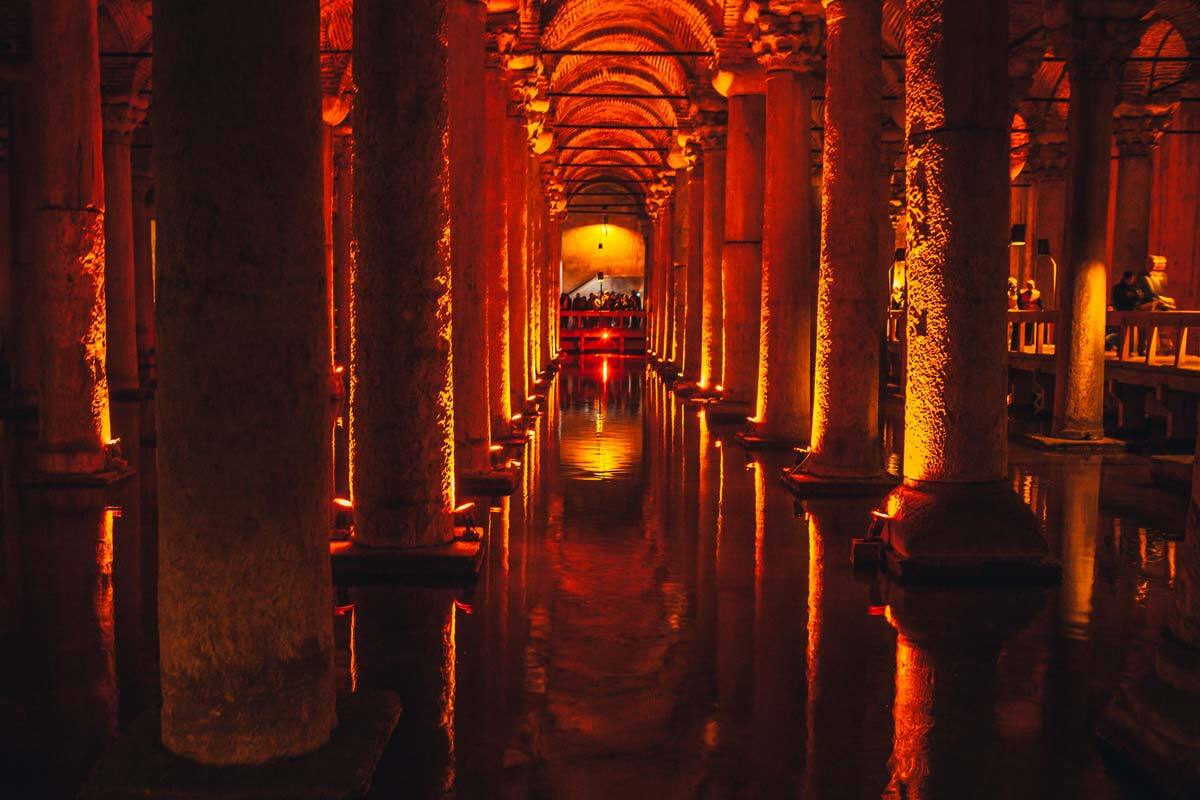
The Basilica Cistern is one of the ancient cisterns that run underneath the city of Istanbul Turkey. At this site, a huge Basilica stood above the cistern, which was built in the 3rd and 4th centuries when Istanbul was known as Constantinople and run by the Early Roman Empire.
The basilica caught fire in 476 and was reconstructed by Illus. The cisterns were used to store water for the city’s public use.
The basilica cistern is the largest of the cisterns in Istanbul and is located 150 meters Southwest of the Hagia Sophia. It is one of the most famous landmarks in Istanbul because of its appearance in popular Hollywood movies such as the James Bond movie, From Russia with Love, and the Dan Brown movie adaptation, Inferno.
23. Myra Ruins
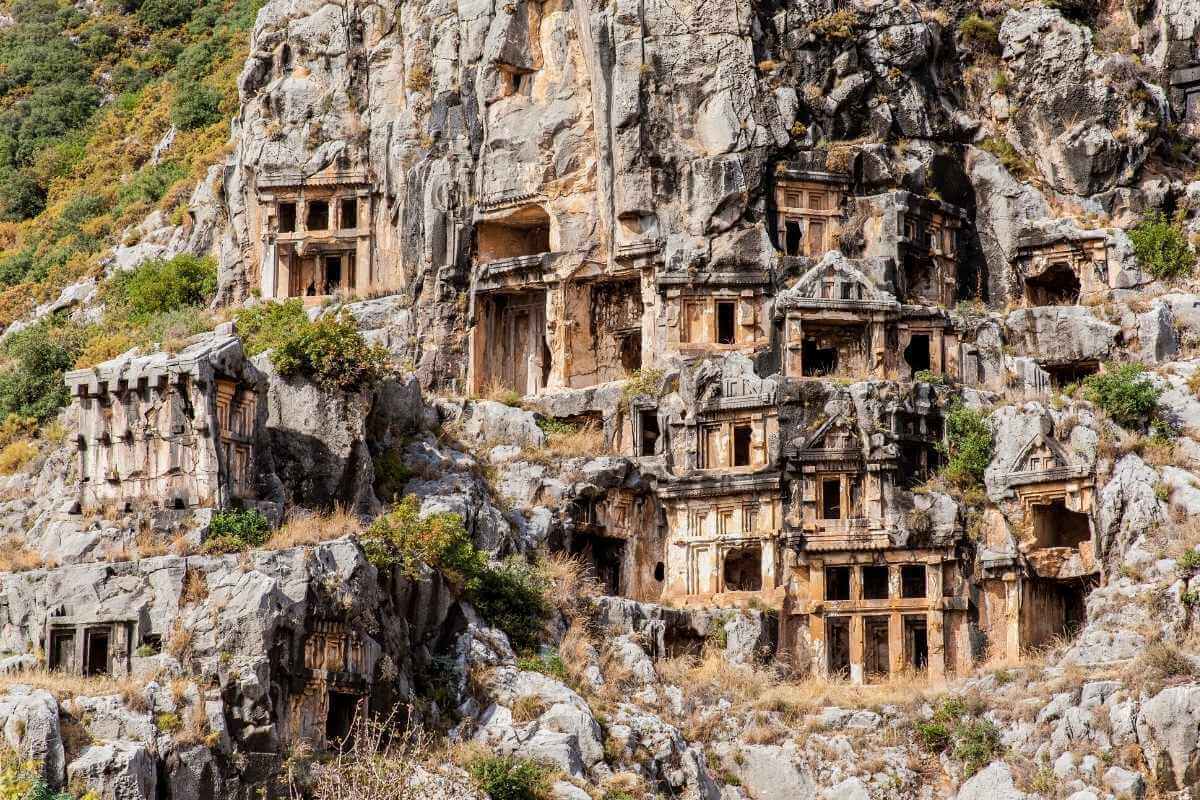
Myra is a small town that has had many names over the years. Today, it is known as Demre and lies in the Antalya Province of Turkey. The city was once a thriving settlement, until 1923 when its Greek inhabitants were asked to leave after a population exchange agreement was passed between Greece and Turkey.
Since then, the ancient city has been abandoned and left in ruins. Some of the most notable Turkish landmarks in the city are the Ancient theatre of Myra, the Church of St. Nicholas, and the rock-cut tombs.
24. Ruins of Ani
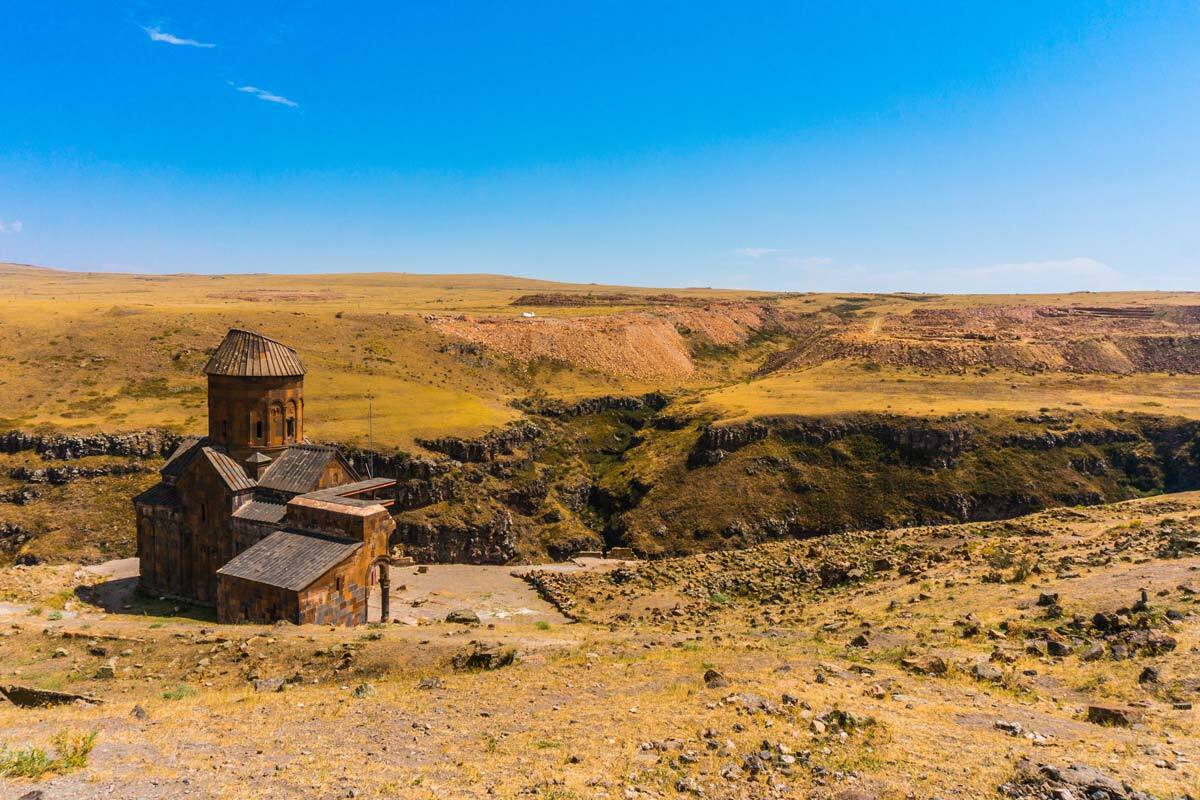
Located close to the Armenian border are the ancient ruins of Ani. The city was the capital of Bagratid in Armenia from 961 to 1045 and was often called the city of 1,001 churches, though today only around 50 churches, 20 chapels, and 33 cave chapels have been excavated.
Ani was an important trade city and in its prime, was one of the world’s largest cities with a population of over 100,000.
When Ani lost its trade links with the Mongols in 1236, it started to decline. In 1319, it was hit by an earthquake, and much of Ani was badly damaged. From the 14th century, trade routes shifted, and by the 17th century, it was abandoned.
It is one of the most culturally significant landmarks in Armenia as well as Turkey and was added to the list of UNESCO landmarks in 2016.
25. The City of Troy
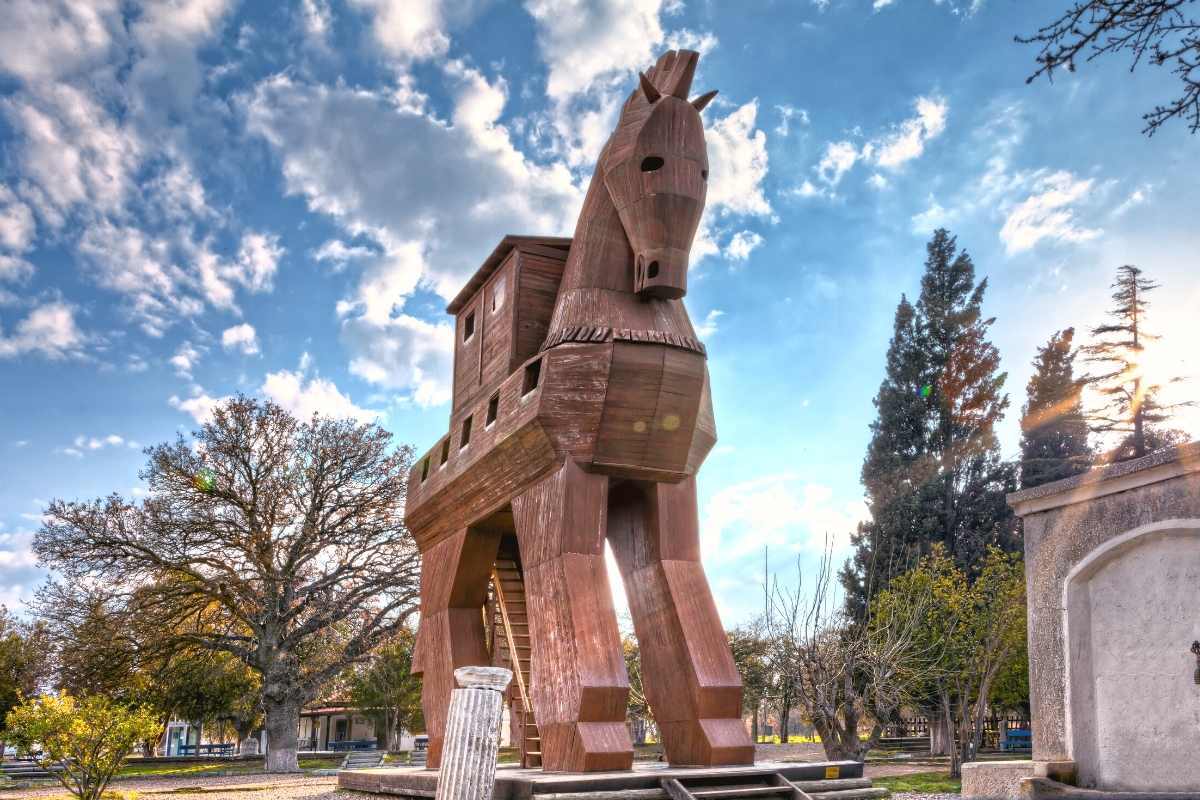
Troy is one of Turkey’s most underrated landmarks. We have all heard the story of the Trojan War, where according to Homer’s Odyssey, Greek soldiers were able to take the city after hiding in a giant horse, which was said to be left as an offering by the goddess Athena.
Whether you believe in the story or not, the city of Troy is still worth a visit. It is located 30 kilometers southwest of Çanakkale and has been a tourist destination since the 4th and 5th centuries by visitors wanting to leave offerings for their heroes. As such, the ruins of this city are well-preserved.
According to archaeological research, researchers believe the city of Troy was built in the Early Bronze Age and was resided in right up until the Byzantine period. It became a UNESCO World Heritage site in 1998.
Final Word on Landmarks in Turkey
As you can see, Turkey’s landmarks are as fascinating as they are stunning. Whether you’re spending a few days in Istanbul, or you’re planning an epic Turkey adventure, you can be sure these landmarks of Turkey are worth a visit.
Do you think we have missed any famous landmarks off our list? Don’t be a stranger. Let us know in the comments!

That was very interesting ????
Visiting Antalya in December, we will definitely be visiting some of the interesting places ????
Thank you
Sagalassos just off the main route from Abtalya to Burdur is a must see.
Hi Jon, thank you for the suggestion! Sagalassos is definitely an archeological site worth visiting in Turkey. There are so many incredible sites in Turkey, it would be impossible to list them all!
Turkey is so beautiful that it must be on the top of anyone’s bucketlist. With so many historical landmarks and natural wonders, Turkey can surely inspire any type of wanderlust.
Turkiye is such a beautiful place I would be insane not to visit, I’m going next weekend and I’ll definitely check out some of the places. One of my close friends is from Turkiye and she said Cappadocia is a must, also Lake Van and the Pink salt sea is also great to add to these lists!
Hi Heather, you may be saddened to hear that Lake Van, the pink salt lake, has pretty much completely dried up due to climate change and is no longer the beautiful spectacle you see in photos. Cappadocia is a definite must-see though. We hope you have a great trip!
Wow! I am impressed to see so many historical and natural landmarks in Turkey. For history and
nature enthusiasts, this country is no less than a paradise.